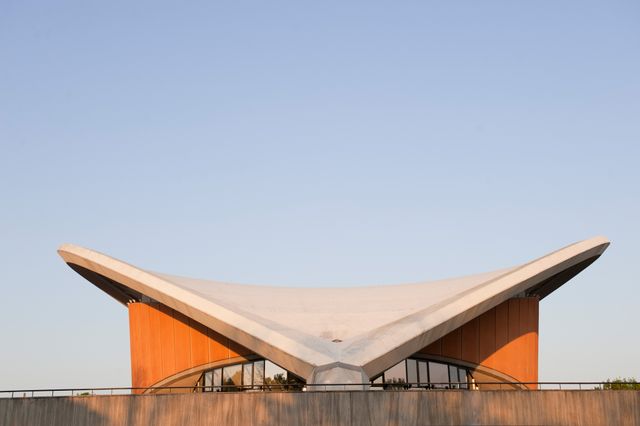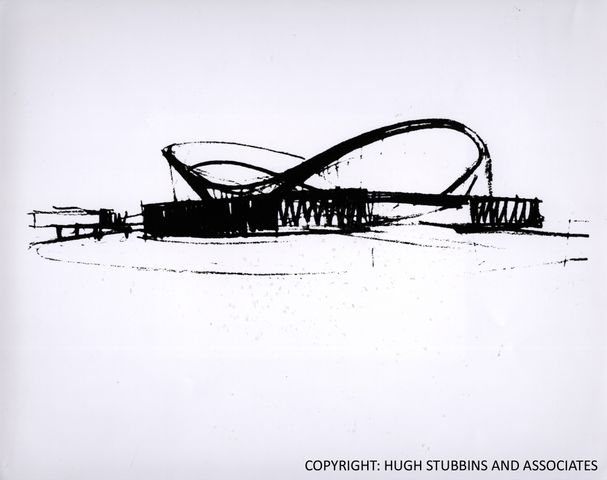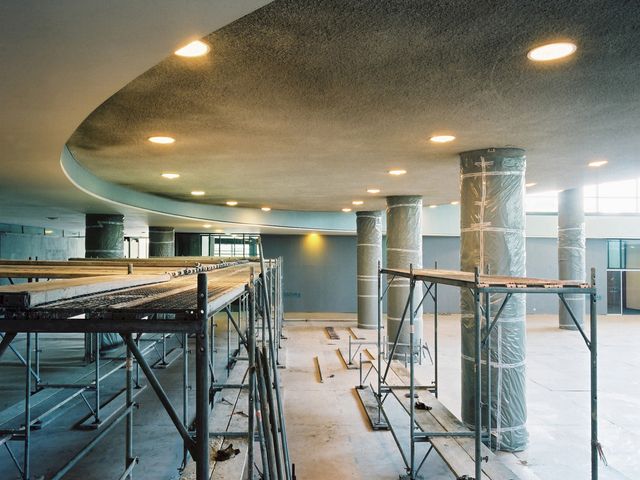The Architecture
The construction of the Congress Hall
Haus der Kulturen der Welt works in a building of great architectural and historical interest. The Congress Hall was the USA’s contribution to the INTERBAU 1957 building exhibition in Berlin. For the exhibition, the designs of many renowned architects were constructed in the nearby Hansaviertel.

In 1955, Hugh Stubbins started work on a design for a building that would soon become a remarkable landmark in the cityscape of post-war Berlin. Stubbins, who had been Gropius’s assistant at Harvard before the Second World War, was familiar with Germany. Wanting to make a statement on that conflict between the systems commonly referred to the Cold War, Stubbins planned a building with a hall to hold cultural events and congresses. It was intended to serve as a symbol and beacon of freedom with its message reaching the East too. The former Zeltenplatz square was chosen as the site. To ensure its contours would be clearly seen from “Communist-ruled” East Berlin, the Congress Hall was erected on an artificial mound.
Stubbins described the symbolic value of his architectural design as “completely free.” The form of the curved roof bore a striking resemblance to that of wings. In Stubbins’s view, the roof upheld the promise that there would be no restrictions on the freedom of intellectual work – a political vision shared by the Benjamin Franklin Foundation, which commissioned the building.
The structural implementation of the program’s claim, however, met with difficulties: Stubbins’s original design was for a free-floating roof supported by only two pillars. The idea of a roof resting only on a few points corresponded to the zeitgeist of organic building of that time. In 1953–1956 Eero Saarinen had constructed a roof for the Kresge Auditorium of the Massachusetts Institute of Technology in Cambridge that rested only on three supports.

But the freestanding roof designed by Stubbins for the Congress Hall was not feasible. They stuck to the idea but an auxiliary structure was needed. The support of an additional ring beam over the outer walls of the auditorium was necessary to shore up the roof on its two points. This structure not only found advocates among architects, but also fierce critics. “Never before has there been a suspension roof with such expensive and cumbersome construction,” wrote Frei Otto in 1956, who had, however, built similar roof shapes as early as 1955 in his Music Pavilion in Kassel. There were safety concerns about the technique given the extremely complicated and delicate structure of the Congress Hall roof.
A gift to the City of Berlin
However, the construction took only one year. On 19 September 1957, after the building had been completed, the US government gave the Congress Hall to the City of Berlin as a present. The artistic program of the opening ceremony reflected the Congress Hall’s future program: combining theatre, symposia and concerts, it brought together prominent artists, scientists and politicians engaged in an international dialogue between the New and Old Worlds.

Roof collapse and reconstruction
On May 21, 1980, 23 years after completion of construction, the disaster happened: the roof of the Congress Hall collapsed, burying a journalist under its rubble. The report on the partial collapse of the Congress Hall came to the following conclusion: “The collapse of the southern outer roof and edge arch of the Congress Hall in Berlin was caused by structural deficiencies in the planning and construction of the outer roofs and, as a consequence, by corrosion-induced fractures in the tendons bearing the arch.”
In 1982, the Senate of Berlin decided to rebuild the hall. Reconstruction, which aimed to implement Stubbins’s essential ideas but also to meet technical requirements and safety regulations, took five years. The reconstruction therefore required some technical modifications. The functions of the roof to both enclose the space and serve as an architectural symbol were separated. Although building such an unusual roof was still a bold undertaking in the 1980s, a solution was devised that met long-term safety requirements. The Congress Hall was reopened for the 750th anniversary of Berlin and for the same occasion, the sculpture Large Divided Oval: Butterfly by Henry Moore was erected in the mirror pond in front of the Congress Hall. Two years later, in 1989, the building became the headquarters of the newly founded HKW.

Partial restorations and historic preservation
The political demand in the 1980s to limit the costs of reconstruction to DM 40 million was met, but at the expense of the technical infrastructure, which was not completely modernized. Over time, the number and extent of damages and thus the cost of their remediation progressively increased, making partial restorations and modernization of the building imperative after the transfer of ownership to the Federal government. The Congress Hall was thoroughly renovated just in time for the building’s fiftieth anniversary in 2007. Further partial repairs under special consideration of historic preservation continue to this day.
